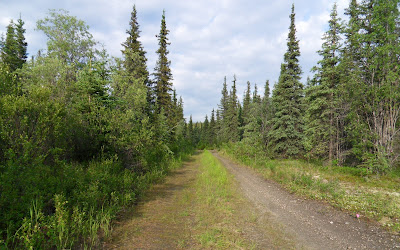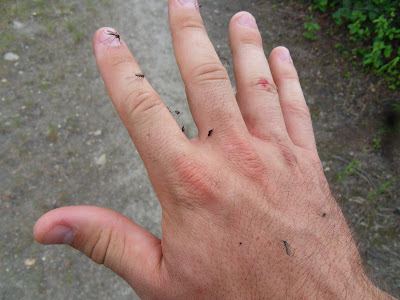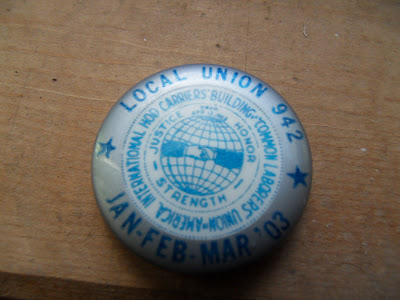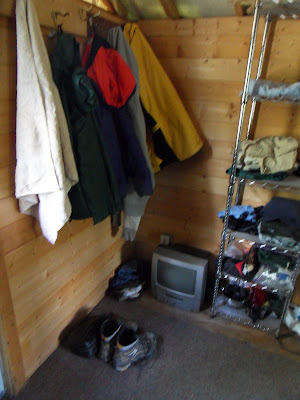I’ve recently been trading emails with a young man who is thinking about hitchhiking up to Alaska. Inspired by those emails, I’ve decided to write this “how to.” I’ve styled this entry as an FAQ, though I should note that I haven’t actually been asked many of these questions, and I certainly haven’t been asked them frequently.
I should also note that while I have hitched for over 8,000 miles across many states and provinces, I do not, by any means, consider myself an “expert.” For anyone looking for serious hitchhiking advice, I suggest
digihitch.com, which is online community of hitchhikers—many of whom make my mileage look miniscule.
*One more word about this post before I get to the actual advice: I believe that sometimes one can over-prepare before embarking on an adventure. Sometimes we plan and prepare so much that we feel obligated to take the path we planned rather than the one fate seems to want us to follow. So I offer this advice with some reluctance as I feel that “learning on one’s own” is one of the greatest joys of doing anything. But sometimes one needs a push, or someone to say “It’s possible; you can do it.” So this post is my way of saying “It’s possible; you can do it.”
**Okay, one more word. This post would more accurately be titled “How to long-distance hitchhike through the U.S. and Canada” because I know nothing about hitching elsewhere. If you plan on hhing through Europe or South America or anywhere other than English-speaking North America, I strongly suggest getting advice elsewhere.
I’ve asked many of my drivers, out of curiosity, “Why did you pick me up?” The advice I give below is based entirely on the answers they gave in addition to the tactics I used that contributed most to my success.
Is hitchhiking easy?
Yes. Very much so. I went on a 5,500 hitchhike (hh) from Alaska to New York in 2007 in fourteen days, and 2,500 miles from Mississippi to New York with my then-girlfriend in 2008 in 25 days (we were in no hurry). I’d posit that anybody can hitch a ride, but, like anything else, it gets easier the more you do it.
Where should I hitch rides?
Firstly, you want to do it in relatively safe places, like a thruway rest stop, a thruway entrance ramp, or on a highway just outside of town. You want to be in a place where you’ll feel safe even if you don’t get a ride by nightfall. In other words, you don’t want to be close to a city, where there are little to no places to camp.
It’s crucial that you pick a place where:
(1) The driver is going slow enough to see your sign [ideally less than 30 mph], and
(2) the driver has plenty of space to comfortably pull over going at that speed.
(Drivers, of course, are going very slow on ramps and at rest stops.) Just after a stop light at the end of a town or city is also a good place because, at that red light, they will be able to see your sign and get a good look at you, affording them a moment to contemplate picking you up.
Should I use my thumb or sign?
I’ve used my thumb only once or twice. I’ve been told and I’ve discovered that it takes a lot longer to get a ride using only your thumb. Instead, I strongly encourage using a sign. A sign communicates a couple things to your driver: it says that you’re not just some aimless drifter, but that you’re going somewhere and that you have a plan and that, because of these things, you’re likely to be more responsible and trustworthy. Plus, when the driver sees the town’s name (“Charleston”), and recognizes that he’s going to or through that town, he’ll be more likely to help because he knows he will be able to help.
How do I make a sign?
Find cardboard. You can get cardboard at any gas station or McDonalds or just about wherever. Just ask someone working there for an old box, and they’ll be happy to give you as much cardboard as you want. Make your signs really effin’ big. Use the whole box. They should be, at minimum, two feet tall and three feet wide. The bigger the better. And your writing should be very big and legible. A black marker will work, but I use crayons because
(1) there is no ink so you won't run out,
(2) the colors are more eye-catching, and
(3) they communicate friendliness to your driver in a way that a black marker can’t.
Always think about your driver. To pick you up, he needs to see
(1) where you’re going based on your sign, and
(2) he needs to get the impression that—from the looks of you—you won’t kill or harm him. So having a big legible sign makes things easier for him.
What town/direction should I make my sign out to?
There is a complex art to this, which you’ll learn by trial, error, and common sense. If you’re going 1,000 miles in one direction, sometimes it’s a lot easier to use one directional sign (“north”) over and over again, rather than making a new one for every next town on the map (“Charleston”). Drivers, sometimes, will not like the ambiguous nature of a directional sign; they might be more likely to pick you up if they recognize the town written on your sign.
If you’ve been stranded on the side of the road for an unreasonably long time, it might have a lot to do with what you’ve written on your sign. (Always have an extra square of cardboard.) On my hh from Alaska to New York, it would have looked ridiculous to put “New York” when in Tok, Alaska. (I put “Whitehorse”—the next big town—instead.) If I wrote “New York,” drivers will either think I’m crazy or that there’s no point in picking me up since they aren’t going nearly that far. In cases like these, you’re better off writing down the name of the next big town.
What should I take with me?
Firstly, you must learn a little bit about where you’re going. If you’re headed to Fairbanks, Alaska in October, you must prepare for very cold weather. If you’re going to Seattle, you better have a poncho and a pack cover. I’d recommend checking out the average “low temperature” for the coldest place you’re going at that point in the year, subtract 10 degrees from it and then make sure you have the gear to survive that. (And presume there will be freezing rain at the same time.) If you prepare for the worst, you’ll be fine.
It is good to have a pack with you. If you’re hitching without a pack, drivers will think you’re some aimless, pathless drifter and be less likely to pick you up. (Several drivers have mentioned this to me.) And a pack, of course, will help you prepare for a variety of situations.
Think of hhing cross-country as just a really long camping trip. Obviously, where you’re going—whether it’s hot or cold, or wet or dry—will alter the contents of your pack, but, if I were heading up to Alaska in the summer, I’d carry the following:
Clothes:
Gloves
Winter hat
Baseball cap
2 pairs of pants (jeans/khakis)
2 nice shirts (button up or polo)
2 white tees
Set of long johns or polypro
Jacket
Rain suit
3 pairs of underwear
3 pairs of wool socks
Boots or sneakers
Gear:
Water bottle
Backpacking stove
Propane canister
Tent
Sleeping bag
Tarp (at least 6x8 ft)
pocket knife
headlamp
lighter/matches
cell phone
weapon
industrial garbage bag (to cover your pack in the case of rain and if you don’t have a proper pack cover)
Toiletries:
Soap
Shampoo
Razor and shaving cream
Toothbrush and toothpaste
Deodorant
Misc:
Maps of places you’re going (absolutely essential)
Book for reading
Camera
Crayola crayons
Journal
Wallet with $200
Passport
Food (two or three day’s worth):
Noodles
Breads
Nuts
Granola, etc. etc.
What should I wear?
If you want to get an office job, you’re going to have to show up at the interview in a suit and tie. If you want to hitch rides, you may, similarly, need to acquiesce to the requirements of your driver. That means you gotta dress up a bit.
I make sure all my clothes are clean and reasonably unwrinkled. I tuck my shirt into my pants, and wear nice shirts like polos and button ups. Remember: you want to look innocent and harmless. Of course if you’re in a hippyish community where tattoos and piercings and smelly armpits are the norm, you’ll have no problem getting a ride, regardless of the cleanliness of your garb. But good luck getting a ride in the Midwest.
There are plenty of places to wash up along the way. Motels will sometimes let you pay just a couple bucks for a shower. You can also buy a shower at truck stops. If you’re clean and smell okay, not only are you more likely to get a ride, but the driver will be more likely to give you a longer one.
How can I better my chances of getting a ride?
Again, you want to look innocent and harmless. You can get a ride by sitting on your pack with your sign, but I think you’re better off standing since it’ll make you look less tired and lazy. Always think of your posture. And be sure to look pleasant. You don’t have to smile, but whatever you do, don’t look bored or angry or sad or frustrated. I’d say try to look somewhere in between neutral and happy.
Prepare to be frustrated. Hundreds of cars will pass you without so much as looking at you. But never show your frustration by kicking the ground or swearing or anything that might communicate anger to passing drivers. (In many cases, drivers who saw me turned around after going up the road a bit, only to come back and pick me up. If I had in some way expressed resentment over their initial snub, and they saw it, they never would have turned around.)
Is hitchhiking fun?
God no. Well, sometimes. Realize that, at times, you will have to sit or stand on the side of the road for 12 to 24 hours, sometimes in miserable weather. This is of course extremely boring and tedious and frustrating. Though, it’s arguable that it’s all worth it when someone finally pulls over.
How long should I expect to wait?
This is hugely dependent on two things:
(1) The town/state you’re hitching in and
(2) luck.
In many areas of the country, hitchhiking is still fairly commonplace. In Washington state, I rarely had to wait more than 20 minutes, but in places like Florida or Connecticut—where it’s not so common—I waited more than two hours for a ride. The most I ever waited was 12 hours in a town in the Yukon Territories; the least was less than a minute, both in British Columbia and Vermont. Ultimately, though, I think you can expect to wait 30 minutes to two hours.
How much money should I bring?
If you’re making your own food and sleeping in a tent, you don’t need much. I wouldn’t bring more than $200, plus a debit card. Even though no one has ever tried to rob me, I think it’s helpful to presume that someone will. This way, you won’t bring expensive items like iPhones and laptops and worry about them the whole time.
Do drivers expect anything in return?
No. If they need money, they’ll ask up front. (These are usually the rides I turn down, anyway.) Most drivers only wish to experience the joy of helping someone and the pleasure of having a captive listener. So be thankful—and be sure to play up how much they’re helping you—and be a great listener. I’ve extended many rides by being interested in their life stories (either genuinely or not).
Many times I’ve bought my drivers meals if they picked me up when I was standing in miserable weather or if they took me a far distance or if they went out of their way to drop me off somewhere. This is not required, but it always made me feel better about taking the ride.
Is hhing dangerous?
I think, in general, the level of fear and paranoia most Americans experience is not in accord whatsoever with the actual level of danger out there. In other words, our nation (and hhing) is safer than most perceive it to be. That said, there are still risks of course. When you get in someone else’s vehicle, your driver can easily, say, pull out a knife or gun and make you give him your money or do stuff you don’t want to do. (This never happened to me, but it’s worth considering.)
To decrease the chances of this, do the following:
1. hh in places where there are lots of passing cars (rest stop), which will make a would-be bad guy less likely to screw with you in open view.
2. Don’t hh at night. No one wants to pick someone up at night anyway.
3. Trust your gut instinct. Have a short conversation with your driver before getting in. Ask where he’s going. You only have a split second to determine if he’s a good guy or not. If he even, in the slightest way, gives you the willies, do not get in. (I’ve turned down maybe half a dozen rides because of this.) Just say “No thanks” or that “I’m actually going a lot farther than that” and they won’t be offended. If you have below-average “people reading” skills, don’t hitchhike at all.
Is it dangerous for women?
I don’t know if it’s appropriate to say it’s dangerous for women, but it’s certainly more dangerous for women than it is for men. It should be noted that most drivers are males, either for male or female hitchhikers.
I once hhed with my then-girlfriend for 25 days and we didn’t have any problems, but a couple passing drivers made lewd sexual gestures at her, so if she were alone, such and such a person could very well have been her driver.
While hhing solo is certainly possible, to ensure safety, it would be ideal to travel with a partner (male or female), and I’d strongly suggest carrying an easily accessible knife or can of mace. Also, it helps to call someone or text someone in front of the driver while on the drive, which will also deter crime.
When should I decline a ride?
You should obviously decline a ride if, as mentioned above, you're at all creeped out by your would-be driver, but there are other reasons to do so as well. And this is where the "art" of hitching rides comes in because sometimes—to get where you're going as quickly as possible—it's better to stay put rather than taking a ride.
Consider the following situation: You're on the outskirts of a hippyish town accepting of hitchhikers. The place where you're standing is safe and a large number of vehicles are heading in your direction. There's plenty of room for them to pull over. In other words, you're in the perfect spot to hitch a ride. If someone pulls over and offers to take you six miles when you're trying to go 300, you might be better off declining the ride and waiting for a longer one. You can get dropped off—at this place six miles up the road—and it can potentially be the worst spot to hitch rides out of. In other words, if you know you're going to get plenty of offers, wait for an ideal one, because willing drivers may be few and far between elsewhere.
Where should I sleep?
I carry a tent with me. In many towns—in Northwest U.S., Alaska, or Western Canada—I set up my tent in open view of the road, and felt safe doing it. There are still lots of places where sleeping on the side of the road in a semi or RV or tent is normal and safe. Of course, in other places, it’s weird, and it will give cops cause to harass you. In these cases, you can slip into the woods where you and your tent will be concealed. (Near thruways, there are always woods.)
If you’re stuck in the city, I’d splurge on a hostel or try to find a church or homeless shelter, or even call the cops before trying to sleep in really sketchy places.
What about hhing with groups of people?
It’s easy to hh as a solo male or solo female, or as a male and female couple, or as a female and female duo. But any other combo, I’d guess, would be far more difficult (like two or more males.) Between the people and gear, many drivers won’t have the room to support three hitchhikers. And there’s a certain risk with picking up two males since the driver knows he could be overpowered if the occasion called for it.
What are some other ways to get rides?
You can always ask for rides at truck stops and whatnot. If you’ve been stuck for a while, it might make it a lot easier to offer to pay for his coffee or meal.
Is hhing illegal?
Yes. In many places it is. Hitchhiking is not exactly—from what I know—wholly prohibited in any one state, but there are many places in those states where it is. For instance, hitching on thruways is illegal almost everywhere, except Oregon I think. (However, hitching on thruway entrance ramps is legal in most places.)
I’ve been approached by cops in states like Mississippi, Alabama, Florida, and New York among others—and have been told by all these cops that hhing is illegal and that I can’t be doing this—BUT they almost always let me go and wish me well.
How should I deal with cops?
Kindness and honesty go a long way. Be sure to have an ID to give them so they can run your name through their system. When they realize that you’re clean, you’re usually good to go. If they tell you hhing is illegal, act surprised and be apologetic, and tell them you’ll never hh here again (which will probably be true). Most times they don’t mind too much since they know that, in an hour, you’ll likely be out of their district.
If they’re adamant about you not hhing there, tell them that you’ll find another way or that you’ll walk. (There are no anti-walking laws (except on thruways and some highways)). And once you’re a good ways away from them, you can probably pull out your sign and hitch a ride before the next cop finds you.
Should I hitch on a highway or thruway?
If you’re going for speed, definitely the thruway. You can probably cross the country in under three days if you’re lucky. If you're going for culture, use the highways and seldom-used country roads.
Is it possible to hitchhike in a city or town?
I wouldn’t even bother trying. Go to the very edge of town, where there’s less traffic, and the only traffic is outgoing traffic. If in a city, take a bus or train to the farthest suburb or country town where hitching rides and finding safe places to camp will be easier.
At what time of day should I stop hitching rides?
The last thing you want is to get a ride at dusk and then get dropped off somewhere at night. You want to set up your camping site well before the sun drops, so you can identify safe and concealed places. Obviously “nighttime” depends on the place and time of year, but, in general, just don’t put yourself in a situation in which you need to set up camp in a dark, unknown place.
Any last words of advice?
You’ll never learn exactly how to do it until you, yourself, go out and do it. So don’t worry if you’re not 100% prepared. After all, you can’t have an adventure without the unknown. At the very least, just carry enough clothes to stay warm and dry and you’ll more than likely be fine.
***
If you have advice of your own (or disagree with any of mine), please feel free to comment in the comment section. If you have other questions, please ask away, so I can update and expand this FAQ.


















































